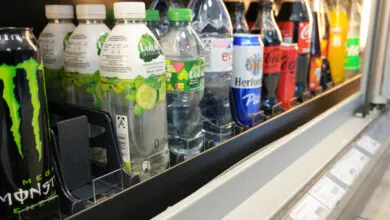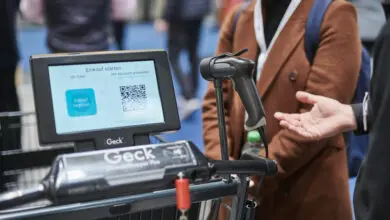Fighting food waste demands a rethink

The four largest German retail organisations, which together operate more than 27,000 grocery stores in Germany, have committed to reducing food waste from their own operations by 30 per cent by 2025. Furthermore, Edeka Group, Schwarz Group (Kaufland and Lidl), Rewe Group, Aldi Nord and Aldi Süd signed a commitment to halve the amount of food thrown to waste by 2030. This initiative from the Federal Ministry of Food and Agriculture was also signed by Norma and Tegut and by food service providers Metro, Chef Culinar, and Transgourmet.
These goals are so ambitious that they are unlikely to be achieved unless retailers fundamentally rethink both the strategy for their store operations and the underlying technology used to support it. Retailers must reconsider the core goals that currently drive operations: The highest possible on-shelf availability, the broadest possible assortment and the most efficient supply chain – everything must be rebalanced against these new targets.
At working groups of ECR Retail Loss, the world of retail comes together to discuss strategies to minimise food waste – many of which are achieving astonishing results. The Retail Optimiser spoke with Colin Peacock, Strategic Coordinator of ECR Retail Loss. In Australia, North America and in the UK, many retailers have adopted cognitive technology to reshape their store operations and tackle food waste. The Retail Optimiser also spoke with Florian Strecker from solution provider Retail Insight about the advantages of this technology.
Food waste is a major problem. In Germany alone, 11 million tonnes of food ended up being thrown away in 2020, according to the National Statistics Office. Of this, 7 per cent (0.8 million tonnes) came from the retail sector. To combat food waste, 14 major German wholesale and grocery retailers signed an agreement with the Federal Ministry of Food and Agriculture in June 2023.
The pact states: “In the wholesale and retail trade, food waste results, for example, from the fact that logistics processes are not optimally set up, order quantities do not correspond to demand or goods have been incorrectly cooled. But these goods may also simply no longer be marketable because, for example, the banana is overripe, the vegetables have gone mouldy, or the best-before date of dairy products has expired.”

By signing the agreement, companies including Edeka Group, Schwarz Group with Kaufland and Lidl, Rewe Group, Aldi Nord and Aldi Süd, Tegut and Norma have committed to implementing specific reduction targets and measures. Food waste at these companies will be reduced by 30 per cent by 2025, and halved by 2030. The agreement came into force upon signing and is valid until 31 December 2031. The implementation of the targets will be reviewed in an annual, public report by the Thünen Institute for Market Analysis.
Commitment of market leaders such as Lidl and Edeka
The companies welcome this voluntary commitment: “As a grocers retailer, we are aware of our responsibility with regard to the prevention of food waste,” emphasises Christoph Graf, Head of Purchasing at Lidl in Germany in a company press release from June 2023: “We are therefore pleased that our goals, which we have developed over the past few years alongside the other members of the Dialogue Forum, are now entering concrete implementation with the signing of the ‘Pact against Food Waste’.”
Since the agreement came into force, company food waste initiatives have been strengthened. “Sustainability commitments are very important to us – for us, this also includes actively engaging to minimise food waste. Edeka Group is therefore investing in modern merchandise management systems and effective sustainability measures to reduce food waste throughout the supply chain,” says Claas Meineke, Chief Marketing and Sales Officer at Edeka: “But we also need a clear legal framework that makes it easier for us to donate food. With today’s voluntary commitment, we are once again highlighting the significance of this topic for the Edeka Group.”
However, the goals are so ambitious that they are unlikely to be achieved unless retailers fundamentally rethink both their store operations strategies and the technology employed to achieve them. Since 2014, retail giants including Tesco, Ahold Delhaize and Germany’s Schwarz Group have been jointly discussing strategies to combat food waste at a global level in a dedicated working group of ECR Retail Loss, an organisation which emerged out of the European Efficient Consumer Response (ECR) initiative. Recently, the largest US retailers, Walmart, Kroger and Target, South American giant Cencosud and Australian market leaders Woolworths and Coles also joined the food waste group.
ECR Loss develops strategies at a global level
At ECR Retail Loss, over 300 retailers from around the world participate in research and best practice sharing online meetings, all focused on the “dark side of retail”, as Colin Peacock, the group’s Strategic Coordinator, describes it. Together, retailers, CPG’s and academics share their latest thinking and learnings to address the problems of out-of-stocks, inventory inaccuracy, retail theft and food waste. Technology plays, Colin Peacock explains, a major role in these discussions – from both sides: Self-checkout technology as a creator of loss might be one, and technology enablement to fight retail loss another. ECR Retail Loss has and continues to conduct research on the open questions on these problems, making this research freely available to the industry.

“There is a clear relationship between availability and food waste”, explains Colin Peacock, based on their research conducted by the University of Eindhoven. Retailers need to find a sweet spot, this might mean taking a compromise on the highest possible on-shelf availability (OSA). It could make economic sense, for example, to set the goals for OSA differently for slow moving and fast-moving items, the research team from Eindhoven found. With the ‘Fresh Stock Cover (FSC)’, the academics developed a formula that can support assortment managers to identify and evaluate products with high waste. The FSC also enables the retail decision makers to calculate to what extent interventions could help to reduce waste in balance with certain goals for the OSA.
Markdowns need clever strategy
New thinking must also be applied to the goal to offer as many varieties as possible of a fresh food item in one case, to ways to increase supply chain efficiency and to the depth of the assortment. “Instead of nine variants in a category, you might have to go back to three to sell enough and reduce wastage,” Colin Peacock points out.

Food surplus can be significantly reduced through prevention – but not completely avoided, he reports. Thus stores are always likely to have to manage this surplus. This is why the global retail working group is also heavily engaged in the question of discounting fresh products before they are either no longer allowed to be sold because they passed their expiry date, or, like bananas, have brown spots that are completely safe for consumption.
Dynamic markdown is one of the big topics for the retail giants in the Food Waste working group – price reductions that are adjusted in time and amount to achieve the desired sale before the goods become unsellable. The question of how many days before the expiry date retailers should start to reduce goods is answered very diversely in the working group. “While some retailers always start reducing prices three days before a product becomes unsellable, others have started to differentiate on an item-specific basis,” explains Colin Peacock: “For example, some retailers would reduce the price of cheese as early as seven days before the best-before date in order to give customers more time to eat the fresh but with limited shelf-life products at home, others would reduce the items on the day of the expiry date itself.”
Execution of markdowns is not trivial
A major factor influencing how often prices of an item are reduced is, for the major retail companies involved in the Food Waste working group, the question of how much manpower can be made available for this purpose. According to Colin Peacock, retail managers are also discussing the question of whether electronic shelf labels (ESLs) can be a smart solution to display the reduced prices. A second label on the shelf could show the customer that goods with a certain minimum shelf life are being sold at a reduced price without the need for price stickers on the individual products. Reduced goods could also be placed separately next to non-reduced products.
There is a growing appetite in the industry to replace the current barcode on products, especially fresh items, with 2D codes via the GS1 organisations. For food waste, this is seen as a critical enabler to a step change in food waste reduction.

But already today, numerous large companies have started to use 2D codes with the batch number, and thus the expiry date, mainly for fresh meat and fish, reports Colin Peacock from the working group. Woolworths Australia has already been gaining experience with this for three years and reports regularly to the members of the working group. Although many other retail companies, such as Aldi Süd and Aldi Nord, provide their customers with batch-specific traceability information via QR codes on selected products, Woolworths Australia also reads the codes of its meat products at the checkout, so that it is possible to see from the POS data which of these products was sold at which time and with which expiry date.
Transparent processes
“2D codes could be a real game changer,” says Colin Peacock. The codes can be used to block expired products at the checkout as well as those lot numbers for which a recall exists. Last but not least, forecasting systems can get much better results if they can take into account the age of the items in each store. Once retailers’ systems know the age of products in a store, the fight against food waste will be able to be waged with much less staffing resource.
The question of who within the retail companies is responsible for food waste reduction is answered very differently by the participants of the working group. While some delegate the responsibility completely to the stores, others try to establish an overarching responsibility across all departments and trade levels. This is because the central ordering system and process must also be designed in a way that not only out-of-stocks, but also food waste is reduced.
Retailers that offer discounts on products at the end of their shelf life usually do so according to rigid, static tables in which they specify which products are to be reduced in price by what percentage on how many days before the best-before date. Regardless of whether they use historical sales figures to create these rules or not – what they do not consider is the volume of goods that have to be sold off in a certain time period. “There is a compelling simplicity to a fixed discount rate, for example, 30 per cent, however, what the retailers also share in our group discussion is that if you have on any given day, thirty bags of salads in one store, and five bags in another store, that are in both stores will go past their expiry date tomorrow, then there is clearly a case for a steeper discount in the store with thirty bags to sell in a day compared to the store with only five bags”
British Co-operative Group benefits from Cognitive Technology
With dynamic markdown software, the decision of when and how much discount to give on fresh produce at the end of its shelf life, taking into account the number of items to be sold, can be dynamically adjusted to buying behaviour using POS data. Furthermore, the right solution can also consider external factors such as the weather and the day of the week. “The pace of adoption of markdowns as a strategy, and then the use of dynamic markdowns, in the years since this group was formed in 2014 has been significant, we have had many retailers share in our meetings how using dynamic markdowns have meant they sold more to humans, wasted less and saved them the time and costs associated with donating to charities, processing for animal feed donation or sending to landfill,” Colin Peacock reports from the experience of the retailers in the working group.
Transparency about the accurate stock of goods is particularly lacking in many trading companies in the fresh produce sector, and this is already the case without taking into account minimum shelf-life data. This is because in addition to theft and damage, spoiled goods as well as those that are further processed in the store to produce other items are rarely booked out of the systems. Added to this is the challenge that variable-weight items pose to inventory management. The sometimes grossly incorrect stocks in the system again have a negative impact on the forecast quality for orders and often lead to an increase in the problem of food waste.

In the UK, the regional organisations of the Co-operative Group are using a solution from Retail Insight to reduce food waste through dynamic price reductions. The group has committed to halving its food waste by 2030 as part of its ‘Investing in our planet’ programme. “At a product line level, we can determine what can or can’t be reduced and by how much. The increased confidence that we can target specific products and not others, means we can reduce products in areas where there are legal considerations,” Mark Winter, Retail Analyst der Co-op East of England, is quoted on Retail Insight’s website.

Optimisation uses also POS data
“A big advantage of our solution is that it not only calculates the optimal price reduction at a certain point in time also with regard to the quantity to be sold with Cognitive Technology through our advanced analytics software, but that it guides the staff on the sales floor –both to the product needing to be reduced and through the process,” explains Florian Strecker, Retail Insight’s Vice President for the DACH region.
This not only increases the efficiency of the markdown process, he adds, but also creates the highest level of transparency for all levels of retail organisations – and thus protection against price reduction fraud. The WasteInsight solution, which according to Florian Strecker is already being used in over 28,000 stores worldwide, not only enables dynamic markdowns, but also directs goods that should be routed directly to charity as it does not make economic sense to discount them.
Based on inventory management by expiry date, which the solution enables, it alerts the responsible staff member on the floor via integration into the retailer’s existing task management solution when an action is required: a precisely fitting price reduction or the removal of items with a certain expiry date from the shelf.
Last but not least, the Retail Insight solution analyses historical sales data in correlation to waste and markdown patterns and helps to both optimise sales forecasts for replenishment and identify products that should be better discontinued for economic reasons.




